Canon LBP-1210 User Manual
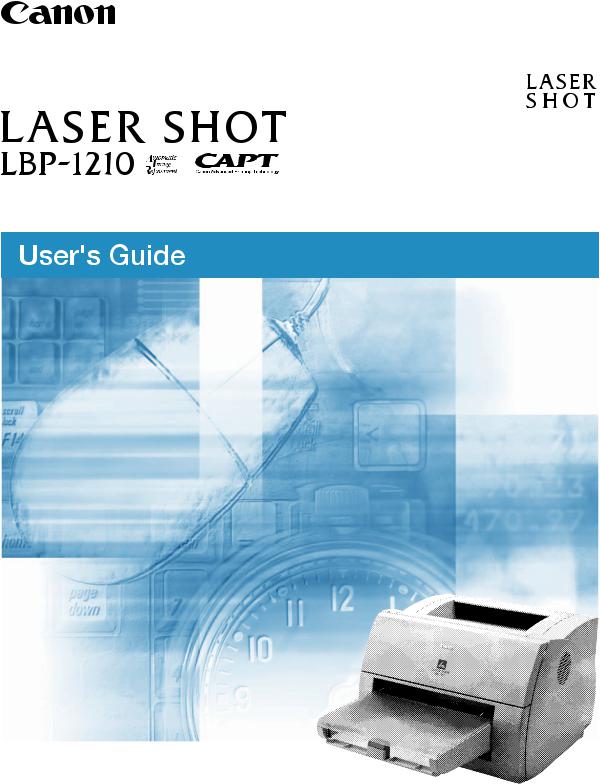
Laser Beam Printer
User's Guide

LBP-1210 Laser Printer
User’s Guide
IMPORTANT:
Read this manual carefully.
Use this manual when you need quick reference help.

Copyright
Copyright ©2002 Canon Inc.
All information in this manual is copyrighted. No part of this publication may be reproduced, transmitted, transcribed, stored in a retrieval system, or translated into any language or computer language, in any form or by any means, electronic, mechanical, magnetic, optical, chemical, manual, or otherwise, without prior written consent from Canon.
Notice
Canon makes no guarantees of any kind with regard to this manual. Canon is not liable for errors contained herein or for consequential or incidental damages incurred as a result of acting on information contained in the manual. The information contained herein shall not be reproduced in whole or in part without prior written consent from Canon.
Trademarks
LBP, Canon, LASER SHOT, and the Canon Logo are trademarks of Canon Inc.
Microsoft®, Windows®, and Windows NT® are either registered trademarks or trademarks of Microsoft Corporation in the United States and/or in other countries.
Other brand and product names are trademarks or registered trademarks of their respective companies.
In this manual, Microsoft®, Microsoft® Windows®, and Microsoft® Windows NT® are referred to as Microsoft, Windows, and Windows NT respectively.
ii
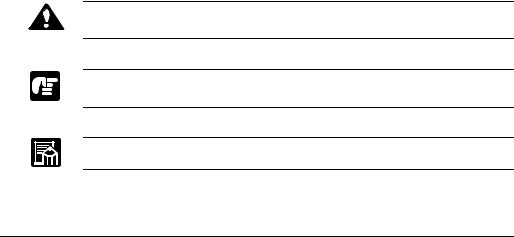
About this Guide
The following lists the information included in this guide:
Chapter 1: Introduction. Introduces you to the printer features and describes the parts.
Chapter 2: Paper Handling. Explains the types of paper and sizes you can use, how to load paper, and describes how paper moves through the printer.
Chapter 3: Using the Canon Advanced Printing Technology.
Describes the Canon Advanced Printing Technology and how to install and use the software, as well as how to check on the status of a print job.
Chapter 4: Troubleshooting. Contains helpful information on how to solve printing problems.
Chapter 5: Maintenance. Explains how to clean and handle the printer, and how to replace the EP-25 cartridge.
Appendix A. Lists the specifications for the printer.
Appendix B. Describes how to connect the printer using the optional network adapter.
Glossary. Includes definitions for terminology used in this guide.
Conventions
This guide uses the following conventions:
CAUTION:
Indicates precautions that must be observed to prevent possible injury.
Indicates that neglecting the suggested procedure or practice could result in damage to the printer.
Indicates notes and memos containing useful tips or detailed information.
iii

Safety Information
FCC Notice (110–127 V model)
Laser Beam Printer, Model L10721A
This device complies with Part 15 of the FCC Rules. Operation is subject to the following two conditions: (1) This device may not cause harmful interference, and (2) this device must accept any interference received, including interference that may cause undesired operation.
Note: This equipment has been tested and found to comply with the limits for a Class B digital device, pursuant to Part 15 of the FCC Rules. These limits are designed to provide reasonable protection against harmful interference in a residential installation. This equipment generates, uses and can radiate radio frequency energy and, if not installed and used in accordance with the instructions, may cause harmful interference to radio communications. However, there is no guarantee that interference will not occur in a particular installation. If this equipment does cause harmful interference to radio or television reception, which can be determined by turning the equipment off and on, the user is encouraged to try to correct the interference by one or more of the following measures:
Reorient or relocate the receiving antenna.
Increase the separation between the equipment and receiver.
Connect the equipment to an outlet on a circuit different from that to which the receiver is connected.
Consult the dealer or an experienced radio/TV technician for help.
Use of shielded cable is required to comply with class B limits in Subpart B of Part 15 of FCC Rules.
Do not make any changes or modifications to the equipment unless otherwise specified in the manual. If such changes or modifications should be made, you could be required to stop operation of the equipment.
iv

FCC Notice (220–240 V model)
This equipment has been tested and found to comply with the limits for a Class A digital device, pursuant to Part 15 of the FCC Rules. These limits are designed to provide reasonable protection against harmful interference when the equipment is operated in a commercial environment. This equipment generates, uses, and can radiate radio frequency energy and if not installed and used in accordance with the instruction manual, may cause harmful interference to radio communications. Operation of this equipment in a residential area is likely to cause harmful interference, in which case the user will be required to correct the interference at his own expense.
•Use of shielded cable is required to comply with Class A limits in Subpart B of Part 15 of FCC Rules.
Do not make any changes or modifications to the equipment unless otherwise specified in this guide. If such changes or modifications should be made, you could be required to stop operation of the equipment.
Notice for EMC Directive (220–240 V model)
“This equipment has been tested in a typical system to comply with the technical requirements of EMC Directive.”
•Use of shielded cable is necessary to comply with the technical requirements of EMC Directive.
International ENERGY STAR Office Equipment Program
As an ENERGY STAR partner, Canon Inc. has determined that this product meets the ENERGY STAR guidelines for energy efficiency.
The International ENERGY STAR Office Equipment Program is an international program that promotes energy saving through the use of computers and other office equipment. The program backs the development and dissemination of products with functions that effectively reduce energy consumption. It is an open system in which business proprietors can participate voluntarily. The targeted products are office equipment such as computers, monitors, printers, fax machines, and copiers. Their standards and logos are uniform among the participating nations.
v
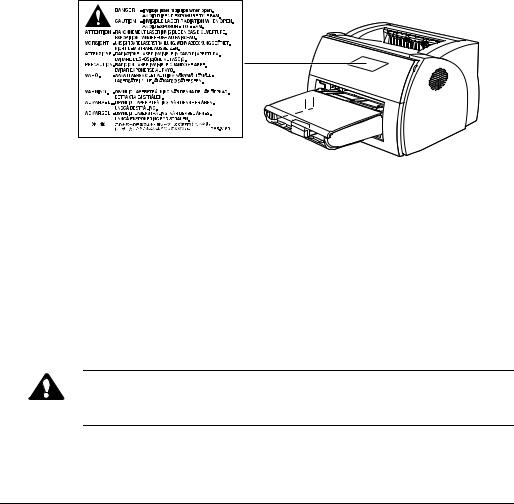
Laser Safety (110–127 V / 220–240 V models)
Laser radiation could be hazardous to the human body. For this reason, laser radiation emitted inside this printer is hermetically sealed within the protective housing and external cover. In the normal operation of the product by the user, no radiation can leak from the machine.
This printer is classified as a Class 1 laser product under EN60825- 1:1994, and in the USA, it is classified as Class 1 under the code of Federal Regulations, §1040.10 of Title 21.
The label shown below is attached to this printer. This label is attached to the laser scanner unit inside the printer. (110–127 V / 220–240 V models)
This printer has been classified under EN60825-1:1994 and conforms to the following classes:
CLASS 1 LASER PRODUCT
LASER KLASSE 1
APPAREIL A RAYONNEMENT LASER DE CLASSE 1
APPARECCHIO LASER DI CLASSE 1
PRODUCTO LASER DE CLASE 1
APARELHO A LASER DE CLASSE 1
(220-240 V model only)
CAUTION:
Performance of procedures other than those specified in this manual may result in hazardous radiation exposure.
vi
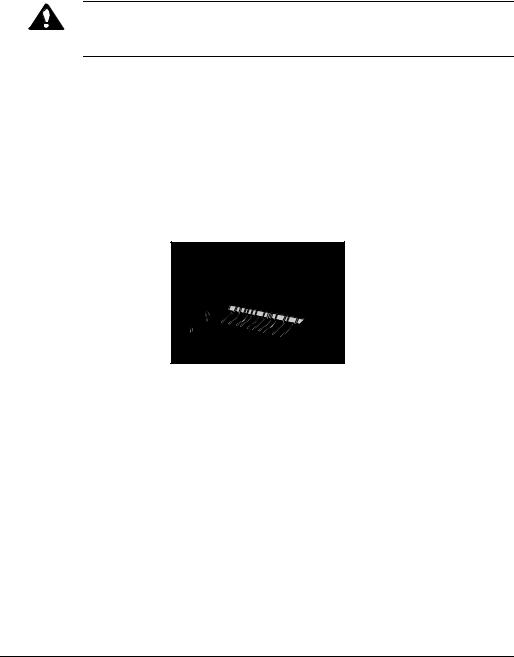
Important Safety Instructions
CAUTION:
This printer is a high-precision electronic device. Before operation, be sure to read the following instructions to handle the printer properly.
Read the manual carefully before operation.
Do not dispose of these instructions. Save them for future reference.
Follow all warnings and instructions on the printer and consumables.
Do not place the printer on an unstable cart, stand, or table.
When installing the printer, carefully observe the location requirements described in this guide.
The shaded part of the face-up delivery area may be hot. Be careful not to touch it.
Do not expose the printer to a wet environment.
Do not expose the printer directly to a chemical environment (experimental laboratories, etc.). The exterior of the printer is made of plastic, and the outside covering might fade, become deformed, or melt.
Do not install the printer where it will be exposed to smoke or steam.
Be sure to connect the printer to a grounded outlet.
Do not operate the printer until all packing materials (packing tape, spacers, and styrofoam molds) have been removed.
vii

110–127 V model only:
This product is equipped with a 3-wire grounding type plug, a plug that has a third (grounding) pin. As a safety feature, this plug fits only into a grounding-type power outlet. If you are unable to insert the plug into the outlet, contact an electrician to replace your obsolete outlet. Do not defeat the purpose of the grounding-type plug.
220–240 V model only:
A certified power supply cord is to be used with this equipment. For a rated current up to 6 A, a type not lighter than H05VV-F 3G 0.75 mm2 or H05VVH2-F 3G 0.75 mm2 shall be used.
Be sure to turn off the power before unplugging or plugging in the printer power cord or interface cable.
When moving the printer, be sure to turn off the power before unplugging the power cord.
Be sure to unravel the power cord prior to plugging it in; otherwise it may lead to damage, overheating, short-circuit, or result in fire.
Be sure to plug the power cord firmly into the power outlet, as any flammable material caught between an opening might result in fire.
Avoid using an extension cord. If you must use an extension cord, be sure to take the following precautions. Failure to do this might lead to overheating, result in fire, or cause flickering due to a drop in voltage.
•Be sure not to exceed the allowed rating current of the extension cord.
•Use a short extension cord. Do not connect several extension cords together.
•Make sure that the total ampere rating of the products plugged into the extension cord does not exceed the extension cord ampere rating.
Slots and openings in the cabinet are provided for ventilation. To ensure reliable operation of the printer and to protect it from overheating, these openings must not be blocked or covered. The openings should never be blocked by placing the printer on a bed, sofa, shag rug, or other similar surface.
viii
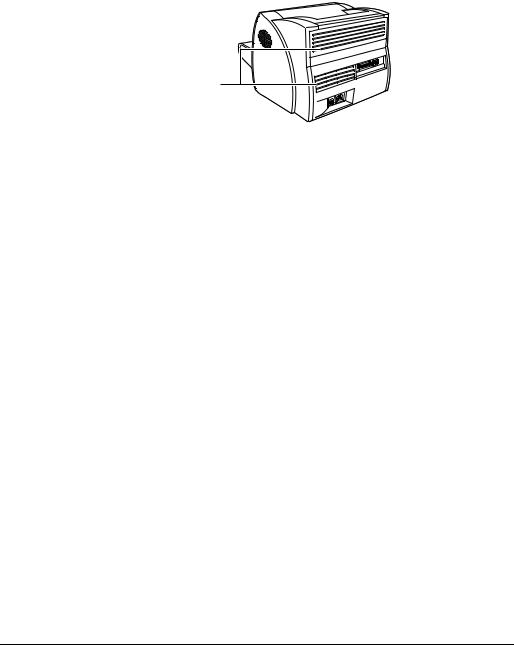
The printer should never be placed near or over a radiator, heat register, or flame. It should not be placed in a built-in installation unless proper ventilation is provided.
Ventilation slots
Before connecting the printer to a power source, check the voltage rating label at the back of the printer to ensure that the printer voltage matches that of the power source. The voltage rating label is located on the rear side of the printer. If the voltage label is missing, contact your nearest authorized dealer or the place of purchase.
The power cord should be routed so that it is not likely to be walked on or pinched by items placed on or against it. Pay particular attention to the plug, the power socket, and the point where the cord exits the unit.
Keep the power cord and cables away from children.
Do not handle plugs with wet hands.
When the printer will not be used for a long period, turn the power off and unplug the power cord for safety.
Unplug the printer from the wall outlet before cleaning. Do not spray liquid cleaners or aerosol cleaners directly on the cabinet or the openings, as the spray could penetrate inside the printer and contaminate internal parts. Use a damp cloth for cleaning.
Never push objects of any kind into the printer through openings in the enclosure, as the objects might touch dangerous voltage points or short out parts. This could result in a fire or electrical shock. Never spill liquid of any kind into the printer.
Unplug the printer and request servicing from qualified service personnel in the following situations:
•When the power cord or plug is damaged or becomes frayed.
•If liquid is spilled into the printer.
•If the printer is exposed to water.
ix

•If the printer does not operate normally when the operating instructions are followed. Adjust only those controls that are covered by the operating instructions, since improper adjustment of other controls may damage the printer and may require extensive work by a qualified technician to restore the product to normal operation.
•If the printer is dropped or the cabinet is damaged.
•If the printer exhibits a distinct change in performance, indicating a need for servicing.
•If the printer produces smoke, odor, or excessive noise.
The outlet should always be free from any obstacles so as to allow easy access.
When unplugging the printer, always disconnect the power cord by pulling on the plug, not the cord itself.
Any misuse of electrical equipment is hazardous. Do not allow children to handle power cords or cables.
Do not attempt to service this printer yourself, except as instructed in this guide. Opening or removing covers that are intended to be removed only by qualified service personnel may expose you to dangerous voltage points or other risks. Refer all servicing in those compartments to qualified service personnel.
Do not attempt to modify the printer.
Do not remove the warning or instruction labels on the printer.
x
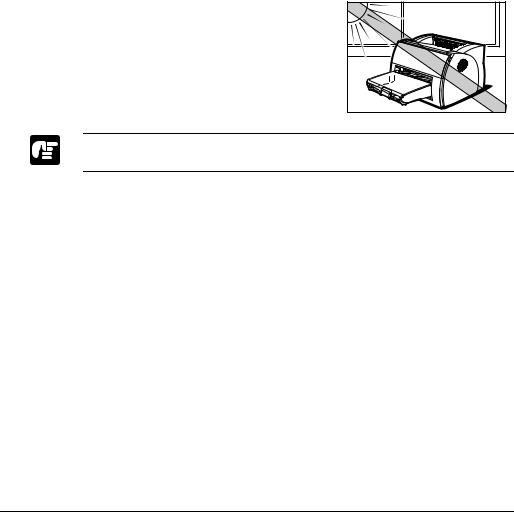
Operating Environment
When selecting a location for the printer, check the following guidelines:
•Make sure the location is flat and sturdy.
•When power is on (printer plugged into an AC outlet): Temperature: 7.5˚C-35˚C (45.5˚F-95˚F)
Relative humidity: 5-90% RH with no condensation
•Make sure the surrounding area is well ventilated.
•The printer must not be in a direct draft.
Avoid placing the printer in the following locations:
• Under direct sunlight, near heaters, air conditioners, or open flames.
Strong light entering the printer unit causes the internal cartridge drum surface to deteriorate and degrades the printing.
•Near magnets or equipment that generates magnetic fields.
•Near areas subject to vibration.
•In dusty places or places where the air contains high concentrations of salt or corrosive gases.
•Near water pipes and refrigerators.
If humidity is less than 30%, use a humidifier or an anti-static mat to prevent buildup of electrostatic charges.
If the room temperature rises abruptly, or the printer is moved from a cool and dry place to a warm and humid place, condensation may form inside the printer and cause problems with paper delivery or a deterioration in print quality and, in some cases, result in printer error. To prevent this, allow the printer to sit for an hour or more to adjust to the new temperature.
xi
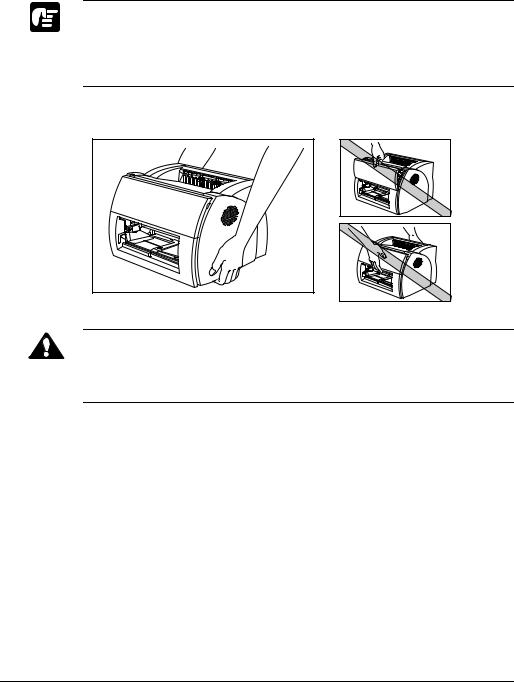
Observe the following requirements when the power is off (printer unplugged from the AC outlet):
•Temperature: 0˚C-35˚C (32˚F-95˚F).
•Relative Humidity: 35-85% RH with no condensation.
Carrying the Printer
CAUTION:
Do not carry the printer by holding the front panel or by holding it at the front and rear. This could result in damage to the printer or personal injury if the printer is dropped.
Before transporting the printer, always remove the EP-25 cartridge and store it in its original protective bag or wrap it in a thick cloth to protect it from strong light.
xii
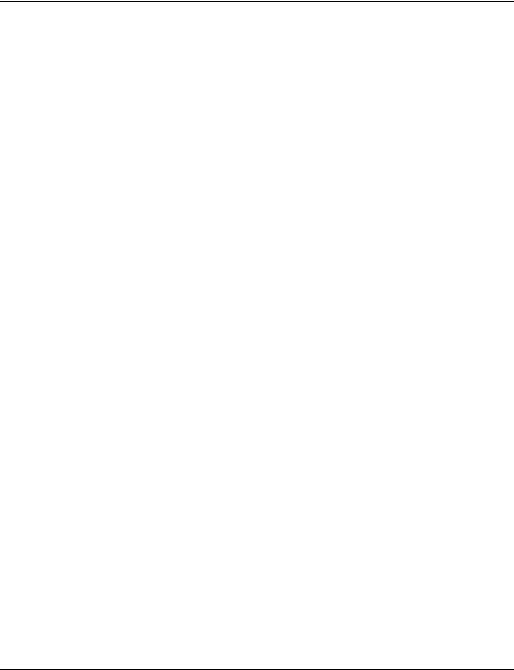
Contents |
|
|
Chapter 1 |
Introduction .......................................................................................... |
1 |
|
Printer Features....................................................................................... |
2 |
|
Parts of the Printer .................................................................................. |
4 |
|
Front View..................................................................................... |
4 |
|
Rear View...................................................................................... |
4 |
|
Inside the Printer ........................................................................... |
5 |
Chapter 2 |
Paper Handling ..................................................................................... |
7 |
|
Paper Requirements................................................................................ |
8 |
|
Plain Paper..................................................................................... |
9 |
|
Transparencies............................................................................... |
9 |
|
Labels ............................................................................................ |
9 |
|
Envelopes .................................................................................... |
10 |
|
Postcards...................................................................................... |
11 |
|
Storing Paper ........................................................................................ |
11 |
|
Paper Path ............................................................................................. |
12 |
|
Selecting Paper Delivery ...................................................................... |
13 |
|
Face-down Delivery .................................................................... |
13 |
|
Face-up Delivery ......................................................................... |
14 |
|
Loading Paper into the Cassette ........................................................... |
15 |
|
Loading Envelopes into the Cassette........................................... |
18 |
|
Loading Paper Manually ...................................................................... |
23 |
Chapter 3 Using the Canon Advanced Printing Technology ............................ |
25 |
|
|
Installing the CAPT .............................................................................. |
26 |
|
Windows 95/98/Me .............................................................................. |
26 |
|
Plug and Play............................................................................... |
26 |
|
Add Printer Wizard ..................................................................... |
30 |
|
Windows NT 4.0/2000/XP ................................................................... |
35 |
|
Windows 2000 Plug and Play ..................................................... |
35 |
|
Windows XP Plug and Play ........................................................ |
38 |
|
Windows NT 4.0 Add Printer Wizard......................................... |
41 |
|
Windows 2000 Add Printer Wizard ............................................ |
45 |
|
Windows XP Add Printer Wizard ............................................... |
51 |
|
Connecting to the LBP-1210 Already on Your Network ..................... |
57 |
|
Network Download ..................................................................... |
57 |
|
Windows 95/98/Me Add Printer Wizard..................................... |
58 |
|
Windows NT 4.0 Add Printer Wizard......................................... |
59 |
xiii

|
Windows 2000 Add Printer Wizard ............................................ |
59 |
|
Windows XP Add Printer Wizard ............................................... |
60 |
|
Printer Sharing...................................................................................... |
61 |
|
Connecting the LBP-1210 as a Network Printer ......................... |
61 |
|
Status Display.............................................................................. |
63 |
|
Canon LASER SHOT LBP-1210 Group.............................................. |
64 |
|
Printing with the CAPT ........................................................................ |
65 |
|
Windows 95/98/Me Printer Properties ........................................ |
66 |
|
Windows NT 4.0/2000/XP Printer Properties and Default |
|
|
Document Properties* ................................................................. |
79 |
|
Checking the Status of a Print Job........................................................ |
93 |
|
Opening the Status Window........................................................ |
94 |
|
Using the LBP-1210 Status Window .......................................... |
95 |
|
Network Printer Status .............................................................. |
106 |
|
The Status Window Icon ........................................................... |
107 |
|
Closing the Status Window ....................................................... |
108 |
|
Messages ................................................................................... |
108 |
Chapter 4 |
Troubleshooting ................................................................................ |
111 |
|
Finding Information............................................................................ |
111 |
|
Paper Jams .......................................................................................... |
113 |
|
Locating Paper Jams.................................................................. |
113 |
|
Removing Paper Jams ............................................................... |
117 |
|
Print Quality Problems ....................................................................... |
124 |
|
Printout Has Vertical White Streaks ......................................... |
124 |
|
Printout Has Black Specks ........................................................ |
125 |
|
Printout Too Light ..................................................................... |
125 |
|
Printout Too Dark...................................................................... |
125 |
|
Printer Problems ................................................................................. |
126 |
|
CAPT Problems.................................................................................. |
129 |
|
CAPT Messages ................................................................................. |
132 |
|
Using the Trouble Shooter.................................................................. |
134 |
|
Uninstalling the CAPT ....................................................................... |
136 |
Chapter 5 |
Maintenance ...................................................................................... |
137 |
|
Handling and Cleaning the Printer ..................................................... |
137 |
|
Handling the Printer .................................................................. |
137 |
|
Cleaning the Printer................................................................... |
138 |
|
EP-25 Cartridge .................................................................................. |
138 |
|
Storage Guidelines .................................................................... |
139 |
|
Handling Guidelines.................................................................. |
140 |
|
Replacing the EP-25 Cartridge.................................................. |
141 |
xiv

Cleaning..................................................................................... |
143 |
Appendix A Printer Specifications ....................................................................... |
145 |
Appendix B Network Adapter: AXIS 1610 ......................................................... |
147 |
Connecting Directly From Clients...................................................... |
148 |
Connecting Through A Print Server................................................... |
149 |
Protocols ............................................................................................. |
149 |
Using NetPilot To Configure Your Network Adapter........................ |
149 |
Installing the Network Print Monitor ........................................ |
149 |
Specifications...................................................................................... |
150 |
Glossary ............................................................................................................. |
151 |
Index ............................................................................................................. |
163 |
xv

xvi
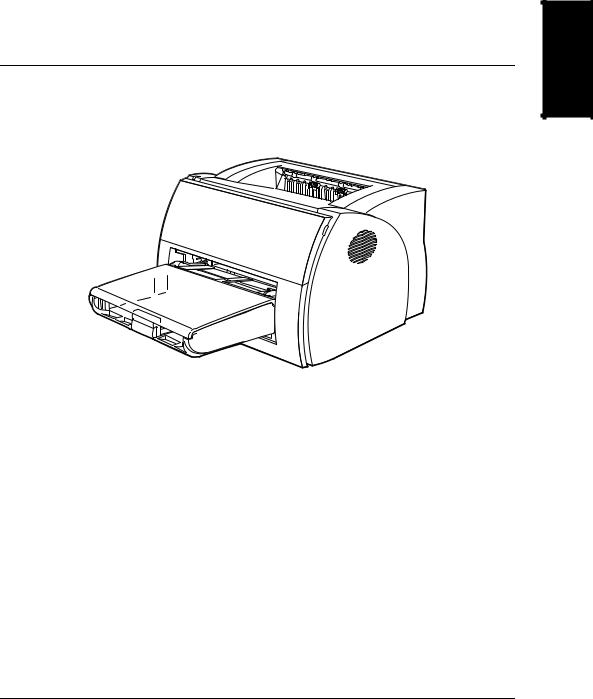
Chapter 1
Introduction
Congratulations on your purchase of the Canon LBP-1210 Laser Printer. This chapter introduces you to the printer and explains its features.
Introduction |
Your new laser printer has many advanced features, including the CAPT (Canon Advanced Printing Technology). The CAPT gives you instant access to printer information.
The LBP-1210 offers outstanding print quality, flexible paper handling, energy-efficient printing, and trouble-free operation.
Chapter 1 |
Introduction |
1 |

Printer Features
The LBP-1210 combines the following features to form a versatile printing system:
Quick startup
The printer is ready to print in less than 8 seconds after it is turned on (start-up time), and has a first print time of less than 10 seconds. This means that you can print documents quickly and efficiently.
Impressive output
Thanks to the CAPT (Canon Advanced Printing Technology), the 600 dpi resolution gives you crisp, clean, laser-sharp output at 14 pages per minute.
Low power consumption
The printer comes with an efficient power management system. Power consumption is very low, particularly when idle.
Stylish, compact design
The printer provides compact, lightweight, easy-to-use functionality in a smooth, stylish design. The small footprint gives you more work space to help you meet your needs.
CAPT Printing Software
The CAPT is easy to install, and with it you can set custom paper sizes, overlay bitmaps on documents (for example, you can print your logo on each page), tile up to nine pages on one sheet of paper, and switch easily between complicated setups using user-defined profiles. The Status Window gives you written and spoken feedback about your print jobs, even over a network.
2 |
Introduction |
Chapter 1 |

Quiet operation |
|
|
Its quiet operation makes this printer an ideal output device, even in an |
Introduction |
|
open-office environment. |
||
|
||
Flexible paper handling |
|
|
Both the cassette and the manual feeding slot accept plain paper of |
|
|
various sizes—Letter, A4, B5, or Executive—as well as transparencies, |
|
|
labels, envelopes, postcards and other special paper. The cassette handles |
|
|
up to 250 sheets of 64 g/m2 plain paper with a maximum stack height of |
|
|
25 mm. For manual feeding, sheets are fed one at a time. Delivery can be |
|
|
face down or face up. |
|
Direct Network Connection
With the optional network adapter, you can connect directly to the
LBP-1210 over a network, without having to go through a server.
Chapter 1 |
Introduction |
3 |
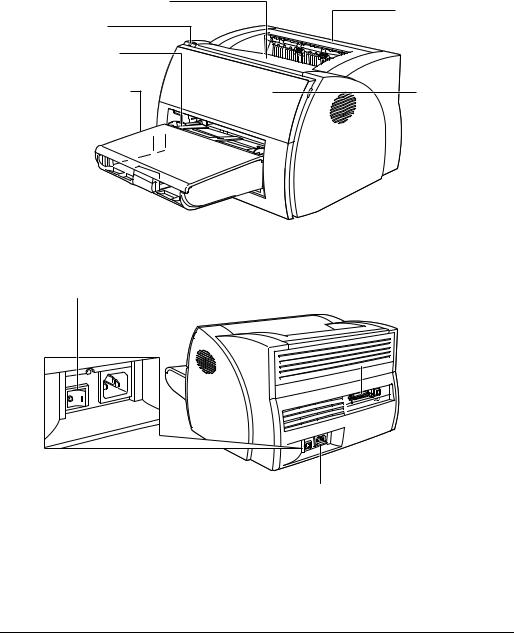
Parts of the Printer
Front View
Face-down delivery slot |
Delivery selection |
|
|
Power lamp |
cover |
Paper guides |
|
Manual feed slot |
Front cover |
Cassette
Rear View
Power switch
 Parallel port interface connector
Parallel port interface connector
 USB port
USB port
interface connector
Power socket 
4 |
Introduction |
Chapter 1 |
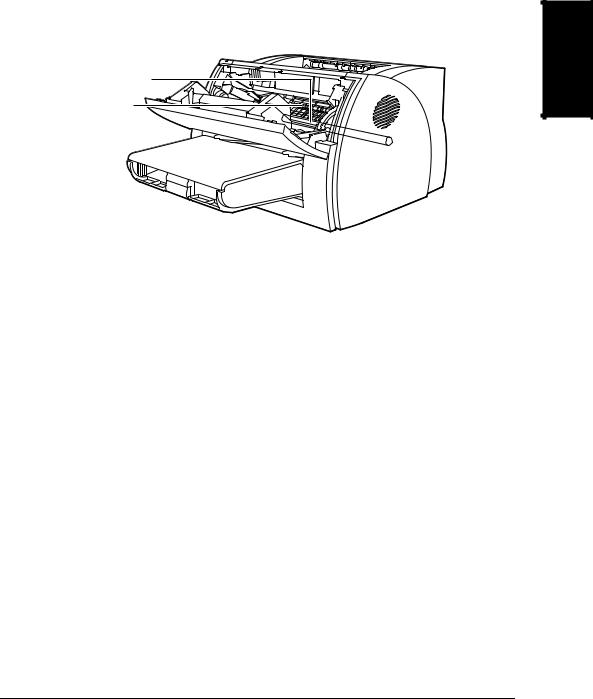
Inside the Printer |
|
Transfer roller |
Introduction |
|
|
Fixing assembly |
|
For more information about setting up the printer, see the Getting Started
Guide.
Chapter 1 |
Introduction |
5 |

6 |
Introduction |
Chapter 1 |

Chapter 2
Paper Handling
This chapter describes how to select the different types of paper you can use with your printer and how to load them. It includes the following information:
Paper Requirements
Storing Paper
Paper Path
Selecting Paper Delivery
Loading Paper into the Cassette
Loading Paper Manually
Paper Handling |
Chapter 2 |
Paper Handling |
7 |
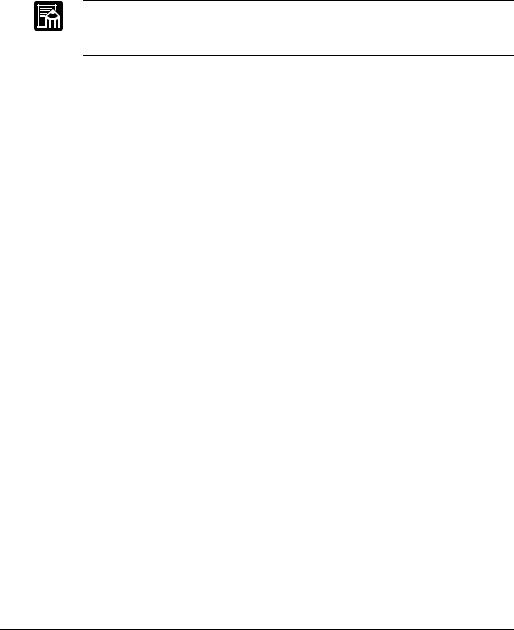
Paper Requirements
Make sure that the paper you use meets the following requirements.
Printing speed may vary depending on: paper size, paper type, or number of pages to be printed. This is due to protective functions working in order to prevent troubles such as breakdown caused by heating.
|
|
|
Weight |
|
Loading |
Type |
Size |
(g/m2) |
Capacity |
|
|
|
|
|
Cassette |
Plain paper |
Letter, A4, Executive, B5. |
64-163 |
Max height: |
|
|
|
|
25mm (Approx. 250 |
|
|
|
|
sheets of 64 g/m2 |
|
|
|
|
paper) |
|
|
|
|
|
|
Envelopes |
98 x 162 mm to |
-- |
Max. height: |
|
|
176 x 250 mm |
|
25 mm |
|
|
(COM 10, |
|
|
|
|
Monarch, DL, B5, C5) |
|
|
|
|
|
|
|
|
Postcards |
100 x 148 mm |
-- |
Max. height: |
|
|
|
|
25 mm |
|
|
|
|
|
|
Other |
Index card: 3" x 5"* |
-- |
Max. height: |
|
|
|
|
25 mm |
|
|
|
|
|
Manual |
Plain paper |
76.2 x 127 mm to |
64-163 |
1 sheet |
|
|
216 x 356 mm |
|
|
|
|
Including the following |
|
|
|
|
standard paper sizes: |
|
|
|
|
Letter: 8-1/2" x 11" |
|
|
|
|
A4: 210 x 297 mm |
|
|
|
|
Executive: 7-1/4" x 10-1/2" |
|
|
|
|
B5: 182 x 257 mm |
|
|
|
|
|
|
|
|
Transparencies |
A4 |
-- |
1 sheet |
|
|
|
|
|
|
Labels |
A4 |
-- |
1 sheet |
|
|
|
|
|
|
Envelopes |
98 x 162 to 176 x 250 mm |
-- |
1 sheet |
|
|
(COM 10,Monarch, DL, B5, |
|
|
|
|
C5) |
|
|
|
|
|
|
|
|
Postcards |
100 x 148 mm |
-- |
1 sheet |
|
|
|
|
|
|
Other |
Index cards: 3" x 5"* |
-- |
1 sheet |
|
|
|
|
|
*Only use index cards that are 0.18 mm to 0.28 mm thick.
8 |
Paper Handling |
Chapter 2 |

Plain Paper
Follow these guidelines when selecting paper:
Paper that is too thick or too thin, or that has irregular shapes, cutouts, or perforations should not be used.
Never use paper that is wet, highly textured, rough, torn, wrinkled, or damaged.
Extremely smooth paper or paper with special coatings does not print well.
The laser printing process uses high temperatures to fuse toner to the paper. Use paper that will not melt, vaporize, offset, discolor, or emit dangerous fumes at about 190˚ C (374˚ F).
Do not use thermal or carbon paper, or paper with glue, staples, clips, or ribbons.
For colored paper, use colors that are not damaged by the heat of the printer’s fixing assembly (about 190˚ C or 374˚ F).
Transparencies
The acceptable size is A4. The transparencies must be able to withstand the heat generated by the fixing assembly (about 190˚ C or 374˚ F) without damage.
Labels
Labels are paper with pressure-sensitive adhesive. Acceptable size is A4.
Note the following conditions when choosing a label sheet:
The label print face (top, or face sheet) must be made of ordinary, matte-finish paper similar to copy paper.
The paper backing must be able to withstand the heat generated by the fixing assembly (about 190˚ C or 374˚ F). The backing must not be made of easily removable coated paper.
Paper Handling |
Chapter 2 |
Paper Handling |
9 |
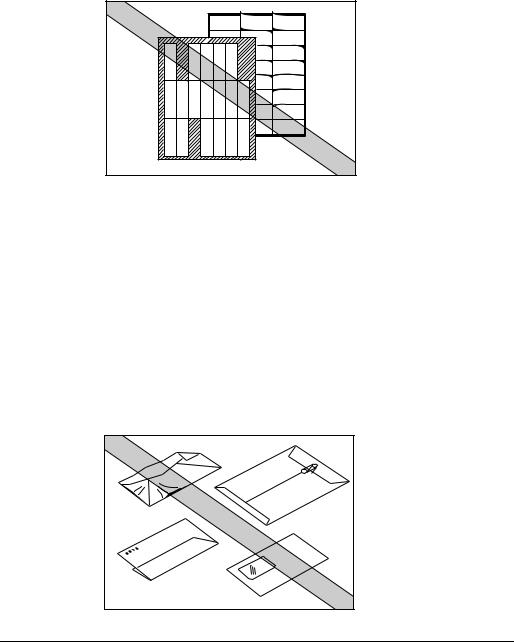
Do not use labels with exposed adhesive, which may stick to the EP25 cartridge or the fixing roller, causing the labels to peel off and serious paper jams to occur.
Envelopes
Follow these guidelines when printing on envelopes:
Envelopes must not have any fasteners, snaps, or windows, or be made of artificial materials.
Do not use envelopes that discolor or melt at about 190˚ C (374˚ F), envelopes which might emit dangerous fumes when heated, or envelopes that seal with pressure-sensitive adhesives.
Do not use envelopes which are damaged, curled or wrinkled, or that have an irregular shape.
Do not use oversized envelopes, or envelopes with folds.
Poorly manufactured envelopes are not recommended.
10 Paper Handling |
Chapter 2 |

Postcards
Follow these guidelines when printing on postcards:
Postcards should not be greater than 0.28 mm in thickness.
Postcards should be free of glue, clips, and staples.
Do not use postcards that are damaged or curled, or that have special coatings or an irregular shape.
Storing Paper
Improper paper storage might cause a deterioration of print quality and paper performance. Therefore, note the following when storing paper:
Store unused paper in its wrapping to protect against humidity.
Do not store paper directly on the floor as the floor is usually humid.
If you must store paper in a very humid place, use a specially designed storage box.
Keep paper on a flat surface to prevent excessive in-ream paper curl.
Do not stack paper too high to prevent excessive in-ream paper curl.
Do not subject paper to direct sunlight or a humid environment.
If paper is moved to a place with a very different temperature, leave it there for about one day before using it; otherwise it could curl or develop wrinkles.
Paper Handling |
Chapter 2 |
Paper Handling 11 |
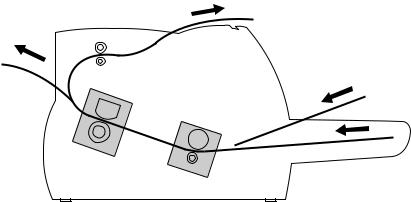
Paper Path
Understanding how paper travels inside the printer helps you better handle paper loading and jams.
A sheet of paper enters the printer from the cassette or the manual feed slot. It travels to the image transfer area where the printer drum has been statically charged. A laser beam changes the static charge on the drum and toner clings to those parts of the drum. As the paper rolls across the drum, the toner transfers to the paper. The toner is then fused to the paper by the fixing assembly. The paper either comes out from the face-up delivery slot or travels to the face-down delivery slot, depending on the paper delivery method selected.
|
|
|
|
|
|
|
|
|
|
|
|
|
|
|
|
|
|
|
|
12 Paper Handling |
|
Chapter 2 |
||
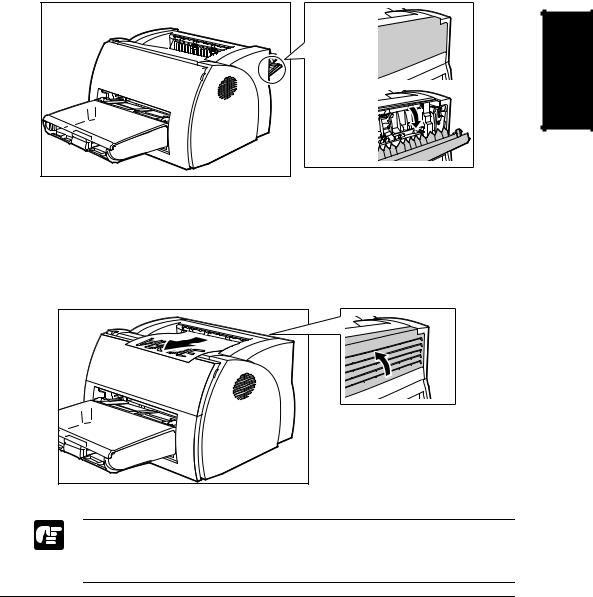
Selecting Paper Delivery
Use the delivery selection cover to choose face-up or face-down delivery. When the cover is open, face-up delivery is selected. When the cover is closed, face-down delivery is selected.
Face-down  Handling
Handling
Paper
Face-up
Face-down Delivery
Printouts are stacked in order in the face-down delivery slot (which can hold up to 125 sheets of 64 g/m2 paper).
To select face-down delivery, close the delivery selection cover.
Do not replace paper in the face-down delivery slot once it is removed from the slot. This could result in damage to the flaps inside the slot.
Never insert paper or other objects into the face-down delivery slot.
Chapter 2 |
Paper Handling 13 |
